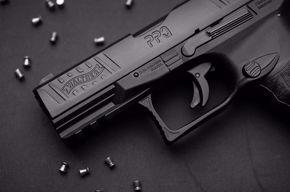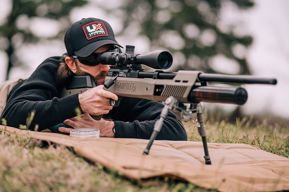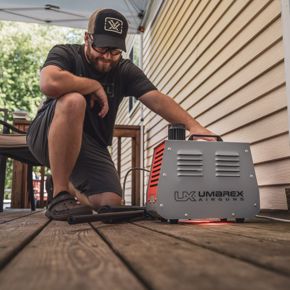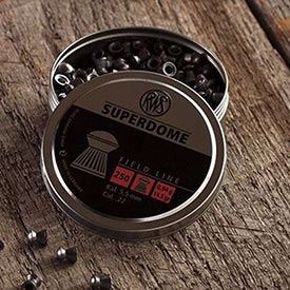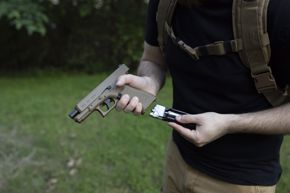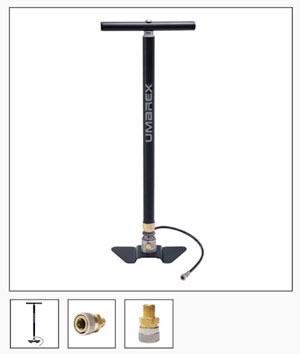 You’ve just bought or you’re considering a pre-charged pneumatic (PCP) airgun. Fantastic! Owners of pre-charged airguns need high-pressure air. So how are you going to fill it? Scuba tank, hand pump, or specialized electric compressor? A scuba or carbon fiber tank can put air in your high-pressure air rifle quite well, but there will come a day when your buddy with the nitrogen tank or big compressor is out of town and the dive shop is closed. The PCP hand pump though never runs out of air! The choice is yours and may be dictated by your budget so here are some airgun hand pump basics and tips for those of us that aren’t quite ready to spend for a compressor or big tank.
You’ve just bought or you’re considering a pre-charged pneumatic (PCP) airgun. Fantastic! Owners of pre-charged airguns need high-pressure air. So how are you going to fill it? Scuba tank, hand pump, or specialized electric compressor? A scuba or carbon fiber tank can put air in your high-pressure air rifle quite well, but there will come a day when your buddy with the nitrogen tank or big compressor is out of town and the dive shop is closed. The PCP hand pump though never runs out of air! The choice is yours and may be dictated by your budget so here are some airgun hand pump basics and tips for those of us that aren’t quite ready to spend for a compressor or big tank.
Air Rifle Hand Pump Tip #1
One of the biggest reasons a hand pump will fail is because it wasn’t allowed to cool down after a five-minute session. So be sure to take breaks not just for yourself, but for the pump! Do not pump longer than about five minutes and let the pump cool down for about 15 minutes between 5 minutes sessions. It’s recommended to bleed the air from the pump after each session to remove more of the heat. This also helps remove some the moisture that collects in the base of the pump. Many air rifles can be refilled or topped off in five minutes or less, so a single session is usually all you need after your initial fill.
A Head’s Up on Moisture in the Air
Anytime you compress air you will get water out of it, more so in humid climates. Even on the "driest" hottest days there is moisture in the air. If you have a garage air compressor (which can’t fill a high-pressure airgun BTW) you know that it has a drain valve on it to get rid of the water in the tank. So, adding an air dryer adapter to your air pump is not a bad idea. It can help remove moister from the air that you’re compressing into your airgun. Some see it as cheap insurance to keep as much moisture out of the gun as possible to prevent the possible and probable internal corrosion. And it’s a good idea to change the desiccant beads every few months too, especially if you use your hand pump regularly. Replace every 4 months (or 2-3 in humid climates). This Hard Air Magazine article shows what moisture can do to your PCP airgun.
---------------------------------•
This Dry Pack Adapter Fits the Umarex SuperFill Hand Pump: Add to Cart »
Stock up on desiccant refills Now. Buy Now »
---------------------------------•
Pumping to 3,000, 3,600 or even 4,500 psi
 You might be able to put max pressure in your Gauntlet, Umarex AirSaber or Hammer, but it's not necessarily easy. There is most certainly some effort is involved. And it intensifies as the pressure builds. Just ask Steve Scott of Safari Hunter’s Journal who ended up having to use a hand pump while hunting in Africa when the compressor died. If you don't mind a workout in five-minute intervals, the hand pump can be a great way to fill a PCP gun. The beauty of regulated PCPs is that you don’t have to pump them all the way up. Just get them beyond the set pressure of the regulator and keep it topped off. And for airguns that don’t have a regulator, like the Umarex AirSaber, determine the amount you’re willing or able to pump to. That might be 3,200 psi. If you’re hunting with it then learning the POI of your first three shots at that psi will put food on the table.
You might be able to put max pressure in your Gauntlet, Umarex AirSaber or Hammer, but it's not necessarily easy. There is most certainly some effort is involved. And it intensifies as the pressure builds. Just ask Steve Scott of Safari Hunter’s Journal who ended up having to use a hand pump while hunting in Africa when the compressor died. If you don't mind a workout in five-minute intervals, the hand pump can be a great way to fill a PCP gun. The beauty of regulated PCPs is that you don’t have to pump them all the way up. Just get them beyond the set pressure of the regulator and keep it topped off. And for airguns that don’t have a regulator, like the Umarex AirSaber, determine the amount you’re willing or able to pump to. That might be 3,200 psi. If you’re hunting with it then learning the POI of your first three shots at that psi will put food on the table.
Using an Airgun Hand Pump Tip #2 : Your Weight
A high-pressure airgun hand pump is built so that you can use the entire weight of your body. When the handle is extended fully use the full weight of your body, or as much as you can, to push the pump down. And be sure to use the full stroke of the hand pump. You’ll find that pumping is fairly “easy” up to 1,500 psi. After 2,000 psi, you'll start to notice increased resistance. Around 2,500 psi you may want to have a buddy alternate with you. When you get to this point, straighten your arms, lock your elbows and wrists and bend at the knees, letting your body weight carry you through the downward pump stroke.
The Most Common Leak
 Many problems with leaking are associated with the O-rings on fill probes like the one that comes with the Umarex Origin .22. Use diver's silicone grease or any other pure silicone grease on these seals to help them make the seal. DO NOT use any petroleum lubrication products because petroleum becomes violently explosive when subjected to high-pressure air.
Many problems with leaking are associated with the O-rings on fill probes like the one that comes with the Umarex Origin .22. Use diver's silicone grease or any other pure silicone grease on these seals to help them make the seal. DO NOT use any petroleum lubrication products because petroleum becomes violently explosive when subjected to high-pressure air.
Hand Pump Use Tip #3 : Pump Slowly
We recommend that you pump with slow, deliberate, full strokes. Stop at the top and bottom of each stroke to let the airflow through the tiny holes inside the air pump. A good rule of thumb is to pause one full second at the top and bottom of each stroke. 3-stage air gun hand pumps work during both the up and downstroke. You will feel the most resistance on the downstroke but don’t discount the upstroke. Bottom line: Go all the way to the end of each stroke, as most of the work is accomplished in the last inch of travel.
The Gauge Needle May Rise and Fall
It can be disheartening to see the needle on an air gauge rise and then fall. It may even take several strokes to raise the needle by a mere 100 psi. The reason the needle is rising and falling is that the air is flowing from the base of the pump, through the gauge and into the reservoir that's being filled. The larger the reservoir, the more pump strokes it takes for the needle to rise and remain there. A larger reservoir (like a 24 cubic inch vs a 14 cu in cylinder), delivers more shots per fill. It may take more pumps to fill it to capacity, but it evens out on the shooting end.
Don’t Forget the Pump’s Bleed Screw
When your air gun is filled to the pressure you want, bleed the pump at its base and disconnect the hose from the gun, in that order.
Hand Pump Maintenance
DO NOT DISASSEMBLE a hand pump beyond what is shown in the owner’s manual! There are o-rings and special grease… well just don’t do it. Do not wipe off or remove any lubricant from the pump shaft. It’s essential to its operation. The best maintenance you can do for your air pump is to use it as directed. Give it a cool-down break and bleed it correctly. You can also periodically lightly lubricate the O-rings of your refill probes, but remember that grease attracts and holds dirt, so they must be protected if they are lightly greased. Just know that high-pressure airgun hand pumps will not tolerate a lot of abuse.
You can find more information about this and many other topics from informed airgunners at Gateway to Airguns.

